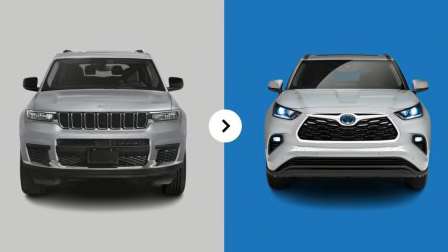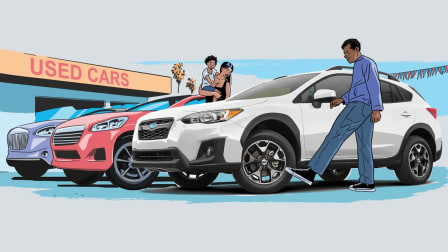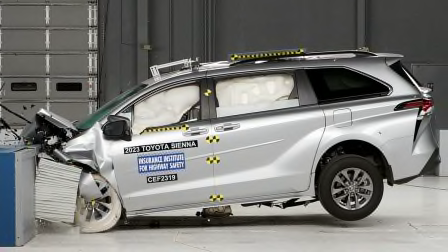Ford’s BlueCruise Remains CR’s Top-Rated Active Driving Assistance System
Systems from Jaguar/Land Rover, Lucid, and Subaru are new to our rankings, and we also tested updated versions from Hyundai and Nissan
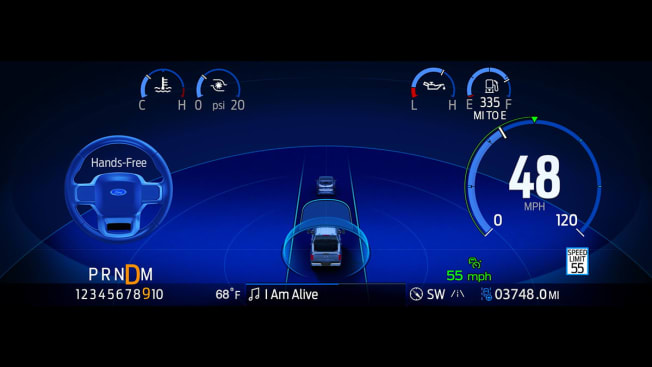
It’s equal parts eerie and amazing to experience Ford’s BlueCruise hands-free driving feature as it takes over your car’s steering, braking, and acceleration while you travel down the highway.
The eerie part is watching the steering wheel turn back and forth on its own, making micro-adjustments to keep the car in the center of its lane, while the system also slows down or speeds up to maintain a safe distance from the vehicle ahead. The amazement soon follows: With your hands off the wheel and relaxing on the armrests as the automated systems take charge, you might start to believe that the age of the self-driving car is finally upon us.
But while BlueCruise’s capabilities are impressive and can make driving more relaxing, cars that can truly and safely drive themselves remain a long way off.
BlueCruise is what’s known as an active driving assistance (ADA) system. In the simplest terms, ADA is the simultaneous use of a car’s adaptive cruise control (ACC) to control speed and lane centering assistance (LCA) to control steering. ACC is an advanced form of cruise control that brakes or accelerates to keep the car a set distance from vehicles traveling ahead of you in your lane. LCA provides steering support to keep the vehicle at or near the center of the lane.
“Systems like BlueCruise are an important advancement that can help make driving easier and less stressful,” says Jake Fisher, CR’s senior director of auto testing. For instance, it can allow drivers to relax their grip and even periodically let go of the steering wheel, while the car maintains a safe distance from other vehicles when driving on a straight, boring section of highway or when stuck in a traffic jam. ADA systems can also have safety benefits, such as potentially keeping you from crossing over a lane line into opposing traffic during a moment of inattention.
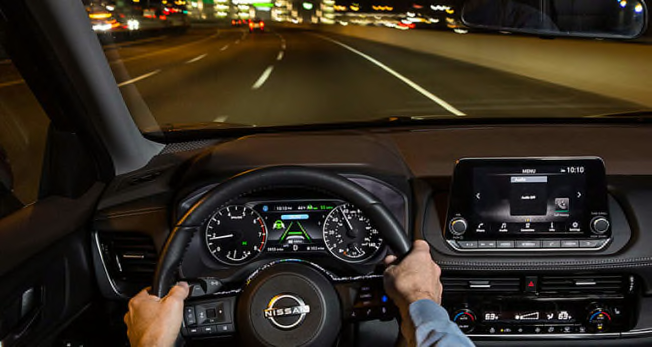
Photo: John Powers/Consumer Reports Photo: John Powers/Consumer Reports
Systems to Help Keep the Driver Safe
Not all ADA systems are created equal. Fisher and other safety experts say that many of them are designed in a way that may lull drivers into complacency, giving them a false impression that the car is handling everything on their behalf. That can be dangerous if the ADA system encounters something it can’t handle, such as road construction or an emergency vehicle, and the driver is not prepared to take back control of the car quickly. In order for any ADA system to be used safely, the driver always needs to remain attentive.
Pnina Gershon, a research scientist at the MIT AgeLab and the MIT Center for Transportation & Logistics, points to data showing that drivers often develop overreliance on driving assistance systems after a relatively short period of use. “We observe frequent situations where the level of attention placed on the road is below what one would traditionally expect a driver to have, especially with the known limitations of these systems, which require drivers to be ready to regain control in a safe and timely manner,” Gershon says. The data also shows that distracted driving is more common when using driving automation systems. “Automation aims to free resources and, not surprisingly, drivers use these ‘freed-up’ resources to do other things than driving.”
The two ADA systems that CR rates highest, the Ford/Lincoln BlueCruise and General Motors’ Super Cruise (Chevrolet/Cadillac/GMC), use direct driver monitoring systems (DDMS) that require drivers to keep their eyes on the road even while the systems are automating steering, acceleration, and braking. Both point infrared cameras at the driver’s face and sound an alert if he or she stops paying attention to the road, even if just for a few seconds. If drivers don’t turn their eyes back to the road, the system soon begins to slow the car.
CR safety experts say that this type of DDMS is key to the safety of any ADA system—and, in fact, CR awards extra points to the Overall Score of tested models whose ADA systems are adequately equipped. Starting with 2024 model-year vehicles, we will deduct points if an ADA system doesn’t have adequate DDMS. Right now, only Ford and GM’s systems meet our criteria for earning additional points, but others could be available soon.
Most ADA systems, however, do not adequately monitor drivers. Instead, they simply require occasional hand pressure on the steering wheel to indicate that the driver is paying attention. This makes it too easy to just give the steering wheel a quick tug without actually looking out at the road. “If an automaker is going to equip a car with an ADA system, they should put in adequate safeguards—or not include both lane centering assistance and adaptive cruise control at all,” says Kelly Funkhouser, CR’s manager of vehicle technology.
Also of concern to CR’s safety experts are the ADA systems from some automakers that allow their vehicles to be driven for an inordinately long amount of time without requiring the driver to apply any pressure to the steering wheel, let alone make sure they are actually paying attention to the road. In our tests, both Mercedes-Benz and Tesla allowed the vehicle to drive down the highway hands-free for about 30 seconds before the first audible alert was given to the driver to put a hand back on the steering wheel. “That means the car could travel more than half a mile on a highway with hands off the wheel and the driver not paying attention at all—that’s a risky situation,” Funkhouser says.
But Hyundai’s latest Highway Driving Assist 2 is even worse. In our testing, the system consistently allowed our drivers to keep their hands fully off the steering wheel for 2 minutes and 15 seconds before the first audible warning was given to put their hands back on the wheel. “That’s simply irresponsible on the part of the automaker,” Funkhouser says.
What We Tested
We only included vehicles in our testing that were equipped with a system that allows for the simultaneous use of ACC and LCA at highway speeds. Models from Mazda, Porsche, Stellantis (Alfa Romeo, Chrysler, Dodge, Fiat, Jeep, Ram) were not included because we didn’t have a vehicle equipped with these features in our fleet when the tests were conducted.
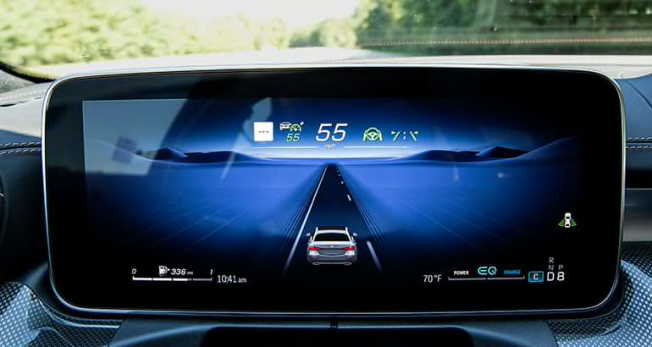
Photo: John Powers/Consumer Reports Photo: John Powers/Consumer Reports
How We Rated the Systems
The 17 active driving assistance systems we tested were put through their paces around the track at our 327-acre Auto Test Center in Connecticut and on a 50-mile loop on public roads between September and December 2022, and between June and August 2023. Each system was rated for its performance in 40 separate tests, such as steering the car, controlling the speed, and keeping the driver safe and engaged with the act of driving. Additional features such as automatic lane changes or reacting to traffic lights were not evaluated in these tests. (Take a tour of Consumer Reports’ $1 million ADAS test loop.)
The specific vehicles we tested generally reflect the performance of other models within each automaker’s lineup equipped with the same systems, but there can be differences among models, model years, and packages that could affect some parameters of how the system operates.
CR testers evaluated the way each of the 17 systems performed within five specific categories: capabilities and performance, keeping the driver engaged, ease of use, clear when safe to use, and unresponsive driver.
Consumer Reports' ADAS Loop
CR expands the tract at its Auto Test Center to help evaluate advanced auto technology.
Capabilities and Performance
Unlike active safety systems, such as automatic emergency braking (AEB), that intervene only momentarily when necessary to help prevent a collision, active driving assistance systems provide continuous support intended to make driving easier—for instance, when you’re on a long, boring highway drive or when you get stuck in a slow-moving traffic jam. For this category, we judged how well each system’s lane centering assistance (LCA) kept the vehicle in the center of the lane, as well as how smoothly and intuitively the adaptive cruise control (ACC) could adjust its speed behind other cars.
When it comes to LCA, the systems from Ford, Mercedes-Benz, and Tesla all gave smooth steering inputs and did a good job of keeping the car at or near the center of the lane on both straight and curvy roads. This type of performance gives confidence to the driver that these systems are highly capable.
The previous version of the Hyundai/Kia/Genesis Highway Driving Assist system was dinged for its less capable steering assistance, which caused the vehicle to ping-pong back and forth between the lane lines—even though it’s intended to stay near the center of the lane. At times it also moved uncomfortably close to a vehicle in an adjacent lane, and our testers noted that occasionally the system was incapable of keeping the vehicle within the lane through curves. The updated Hyundai/Kia/Genesis system—called Highway Driving Assist 2 (evaluated on a Hyundai Ioniq 6)—performed much better thanks to its substantially improved LCA system, which no longer struggles to keep the vehicle near the center of the lane.
The Jaguar/Land Rover Adaptive Cruise w/Steer Assist (tested on a Land Rover Range Rover Sport) performed the worst of any system at keeping the vehicle centered, or even within the lane, on city streets. There were many times the system would suddenly go into a “standby” mode and stop giving steering assistance, and then depart the lane. Other times the steering-assistance remained engaged but the driver still had to intervene to keep the vehicle from crossing over a lane line. It faired much better on the highway—in fact, it almost felt like an entirely different system.
Volvo/Polestar’s Pilot Assist system lost points because it frequently goes into “standby” mode—which is when the system is not giving steering assistance—without a clear warning to the driver. The periodic mode changes create uncertainty as to whether the system is actively providing steering assistance or not, resulting in the driver frequently looking at the instrument panel for verification rather than keeping their eyes on the road.
The Mercedes and Lexus/Toyota ACC systems scored top marks for their well-tuned following-gap distance settings. Our testers found the closest setting to be comfortable in high-traffic areas while still not allowing so much space that other vehicles would continually cut in ahead. We also like that the Mercedes and Subaru ACC systems have settings that allow the driver to adjust the deceleration and acceleration force with which it slows down and speeds back up for traffic ahead.
BMW’s Driving Assistance Professional and GM’s Super Cruise have a driver monitoring camera that ensures the operator is looking at the road ahead when the ACC system brings the vehicle to a full stop, for up to 30 seconds. This provides the convenience of a stop-and-go feature in most traffic jam situations, without the hassle of having to re-engage ACC once traffic ahead starts moving forward again. The camera is there as a safeguard to ensure that drivers are watching the roadway. Most of the other systems change the ACC mode to standby after the vehicle has been stopped for just a few seconds, which eliminates the benefits of using ACC in stop-and-go traffic.
The ACC function of Tesla’s Autopilot system is capable of stopping the car, such as at a red light behind another vehicle, for an unlimited amount of time before resuming again. But without an adequate driver monitoring camera, this is potentially unsafe as there’s no way to know whether the driver is still paying attention when the vehicle starts moving again.
Manager of vehicle technology for Consumer Reports

Illustration: Chris Griggs/Consumer Reports Illustration: Chris Griggs/Consumer Reports
Keeping the Driver Engaged
When a system is controlling a car’s speed and steering, there’s a risk that its driver might feel more free to pick up a cell phone, eat a messy burger, or engage in other reckless, distracting behavior. That’s why we think it’s essential that ADA systems use direct driver monitoring systems (DDMS) to make sure the driver is paying attention to the road. A good system will encourage the driver to stay actively engaged, such as by allowing the driver to give steering inputs without fear of the LCA function shutting off.
A camera-based driver monitoring system that uses head- and eye-tracking technology checks to see whether the driver is looking at the road, and that’s why Ford’s BlueCruise and GM’s Super Cruise are far above the competition when it comes to keeping the driver engaged. While some other systems do have cameras, we found that they will still function even if their cameras are covered, and in some cases the cameras can actually be turned off—neither of which is the case with BlueCruise or Super Cruise. The systems without driver-monitoring cameras require only that the driver place their hands on the wheel every once in a while, which doesn’t necessarily mean the driver is looking at the road ahead.
Ford’s BlueCruise sets a high standard among ADA systems, aided by an infrared camera that monitors the driver’s eyes to determine whether they are looking at the road. If the driver glances away from the road for more than about 5 seconds—whether to look at their cell phone or fiddle with the infotainment screen, or because they fell asleep—the system will give the driver a visual warning and an audible chime. When operating on pre-mapped highways that allow for hands-free operation, BlueCruise prompts the driver in advance of risky scenarios, such as lane merges or curves, to place their hands back on the wheel. This feature encourages drivers to be ready to steer if needed and doesn’t turn the LCA system off when they do.
Both Lucid’s Highway Assist and Nissan’s ProPILOT Assist 2.0 have driver-monitoring camera hardware already in the vehicle. However, in both systems the camera can be toggled “off” within a settings menu, yet the ADA system can still be used. When we asked Nissan the reasoning behind giving drivers the ability to use the new Ariya EV’s ADA system without having to also use the driver-monitoring camera, a spokesperson told us that the automaker would “... continue to monitor the landscape of this emerging technology along with customer feedback and regulatory requirements but (we have) no plans at this time to remove that option on ProPilot Assist for our customers.”
“It’s disappointing that both Lucid and Nissan have this equipment in their vehicles, yet they aren’t using it to the fullest, safest potential,” Funkhouser says.
CR reached out to automakers that have an ADA system but that don’t have a camera-based driver-monitoring system, seeking comment and information on their plans. Several automakers did not respond, while others declined to provide further details, saying the information is proprietary. Of those that did respond, Polestar (Volvo’s EV sub-brand) said DDMS will be included as a standard feature in its upcoming 2024 Polestar 3 SUV. Audi told us that DDMS “is not available at this time.” Rivian acknowledged that its camera is turned off in most vehicles while its Highway Assist system is active, and said it would keep CR posted on its plans for adding DDMS. Mercedes equips some models, like the EQS and S-Class, with a driver-facing camera to detect inattention, but the ADA system continues to operate even if the system deems the driver to be inattentive. And the driver-monitoring camera can be switched off, even when using ADA.
When there’s a seamless collaboration between the lane centering assistance system and the driver’s own steering inputs, it encourages the driver to stay alert and in control.
Manager of vehicle technology for Consumer Reports
BMW and Mercedes ranked at the top when it comes to allowing the driver to give their own steering inputs (known as “collaborative driving”), for example, if you need to swerve out of the lane to avoid a pothole or give some berth to a cyclist. BlueCruise also allows for collaborative driving, and here it distances itself from Super Cruise, Autopilot, Lucid’s Highway Assist, and Rivian’s Highway Assist, all of which immediately disengage the LCA if the driver turns the steering wheel, which—annoyingly—forces the driver to re-engage the system afterward each time. This tells the driver that either the system is steering or the driver, but you can’t have it both ways.
Ease of Use
For many people, the next new car they buy will be their first experience with an active driving assistance system. Because these systems are still so new, it’s important for auto manufacturers to make them as easy to use as possible, with simple controls, clear displays, and good feedback regarding the system’s status so that a driver will know what the system is doing and why it’s operating in a certain way.
Our testers evaluated how easy it was for drivers to engage the systems and make adjustments to the settings. They also reviewed the types and amount of information displayed to drivers, and how easy it was to know and understand what the system was doing.
The Highway Driving Assist and Highway Driving Assist 2 systems found in Hyundai/Kia/Genesis models were the top-rated systems in terms of ease of use (the controls are essentially identical between the two systems), due in large part to a strong showing in the “controls” category. Both the Hyundai/Kia/Genesis systems and Honda Sensing/Acura Watch have separate controls on the steering wheel enabling the driver to activate ACC and LCA independently, which allows drivers to experience and understand each feature on its own. This makes it possible, for example, for the driver to use LCA without ACC if they want. And it prevents the potential confusion of, say, the LCA automatically engaging when the driver activates ACC.
There should be distinct, independent controls for ACC and LCA activation. Combining them into either a single control or a multistep activation removes the freedom for drivers to use each feature on its own. It also implies that the system is more capable than the sum of the two features alone.
Manager of vehicle technology for Consumer Reports
Rivian, BMW, and Mercedes scored very well in “displays.” That’s because the driver’s instrument panel in these vehicles provides detailed information regarding lane lines, showing, for example, how close your vehicle is to the lines and to the surrounding traffic. This helps drivers understand what the system is “seeing,” and thus why the system is behaving the way it is.
By contrast, Nissan/Infiniti’s confusing and poorly labeled symbols on the steering wheel make ProPILOT Assist and the updated ProPILOT Assist 2.0 unintuitive to use and hurt its “ease of use” score.
GM’s Super Cruise would have scored the lowest for “displays” if it weren’t for the bright green LED indicator on the top of the steering wheel rim, which makes it clear when the system is engaged. Beyond that, Super Cruise offers little information in the instrument panel beyond a small, steering wheel icon that indicates the system is active. It doesn’t, for example, show a display of the car, lane lines, or the car ahead, as other systems do.

Photo: John Powers/Consumer Reports Photo: John Powers/Consumer Reports
Clear When Safe to Use
The latest ADA systems are safest to use either on long highway drives or when you’re stuck in a traffic jam—situations in which they can best reduce driver fatigue and stress. On the other hand, using these systems on narrow, curvy roads or around pedestrians can be dangerous and stressful for drivers.
We evaluated the systems in terms of how clearly they communicate in real time about when drivers should—and should not—be using the technology. We also looked at how well they "explain" themselves in instances when the system won’t engage or suddenly turns itself off.
While ADA systems are generally not designed for narrow, curvy roads, most systems do allow drivers to use them in those environments. We think it’s smart that GM’s Super Cruise, Lucid’s Highway Assist, and Rivian’s Highway Assist use GPS-based geofencing to ensure operation within relatively safe driving environments, such as divided highways.
A big difference between Ford’s BlueCruise, compared with GM’s Super Cruise and Lucid’s Highway Assist, is that BlueCruise can be used even when you’re not driving on the highway, while Super Cruise and Highway Assist cannot. Ford is able to incorporate LCA on regular, nonhighway roads because the system requires not just eyes on the road (via the DDMS) but also hands on the steering wheel in certain situations. We also like that even when driving on pre-mapped divided highways that are theoretically “hands-free zones,” BlueCruise requires drivers to place their hands back on the wheel in advance of risky upcoming scenarios, such as sharp curves or lane merges.
Jaguar/Land Rover, Lexus/Toyota, Tesla, and Volvo rank toward the bottom of the chart in terms of making it clear when they are (and are not) safe to use. Tesla’s Autopilot and Lexus’ Safety System+ 3.0 are both capable of being used even when there’s only a single lane line down the middle of the road, which can lead to the driver using them in an unsafe situation. The systems try to create a “center” of the lane but often end up steering too close to the unlined edge of the road.
We were disappointed with Volvo/Polestar’s Pilot Assist system for numerous reasons, including that we found too many instances where the system switched itself into standby mode—meaning the ACC is still controlling the car’s speed, but the LCA is no longer giving any steering assistance—for no apparent reason. “The result is that Pilot Assist isn’t all that helpful to the driver. Much of this could have been solved had Volvo simply installed a driver-facing camera,” Funkhouser says. We plan to evaluate the Polestar 3 when it comes out with a DDMS.
Other than BlueCruise and Super Cruise, the ADA systems we tested don’t make it clear to drivers when they are safe to use. Plus, we find that most vehicle owner’s manuals are overly vague, making the systems seem more like tools used to reduce manufacturer liability rather than to help drivers fully understand, and use, these high-tech features.
Manager of vehicle technology for Consumer Reports
An Unresponsive Driver
Systems that are capable of controlling the steering and speed of a vehicle should also be designed to help the driver at moments of greatest need, such as an incapacitating health emergency or if the driver falls asleep at the wheel. We evaluated how effectively the systems escalate driver warnings and assume steering and speed control in such scenarios, paying particular attention to how long it takes before the first audible warning sounds (because an inattentive or sleeping driver probably would not see a visual warning).
Although most vehicles in our testing can’t monitor the driver’s eyes, most do have a system that will signal an alert if the system deems the driver to be inattentive for a sustained period and then bring the car to a stop (with hazard lights on) and even call for outside help.
Ford’s BlueCruise is the best at discerning when a driver is being inattentive, thanks to its DDMS. If the system detects that the driver isn’t looking forward for 4 to 5 seconds, an audible warning alerts him or her to watch the road.
If the driver is unresponsive, however, BlueCruise merely slows the vehicle to 6 mph and continues driving in the same lane indefinitely. It doesn’t bring the car to a complete stop, put on the emergency flashers, or call for help. By contrast, with GM’s Super Cruise and Mercedes’ Driver Assistance, if the driver doesn’t respond to prompts from the system to re-engage, the car will turn on the emergency flashers, bring the car to a full stop (in whatever lane it’s currently traveling), and call for help. We think that’s the smarter response.
It’s alarming that, with the Honda and Kia systems, if a driver becomes unresponsive to warnings to put their hands on the steering wheel, the ADA systems will shut off before bringing the vehicle to a stop. This means that if the driver is distracted or medically impaired, the vehicle will just continue to roll forward—potentially off the road at speed—without any steering assistance or speed control, until it eventually rolls to a stop or runs into something.
Manager of vehicle technology for Consumer Reports
Hyundai’s newer system—Highway Driving Assist 2—isn’t any better than the original system in this regard. In fact, in some ways it’s worse. Once Highway Driving Assist 2 determines that the driver is unresponsive, the system deactivates the LCA aspect, but the ACC will maintain the vehicle at a speed of 40 mph, without steering assistance, rather than letting the vehicle roll to a stop. Similarly, Subaru’s system also shuts off the LCA but keeps ACC on at the set speed without slowing.
Other than BlueCruise and Super Cruise, none of the systems we tested will alert the driver to pay attention if they are merely resting a hand on the steering wheel with a light amount of pressure, despite the fact that the driver may not be looking at the road and could even be asleep.
Test-Drive Before You Buy
When shopping for a new car, be sure to have the salesperson walk you through the details of how these advanced technologies work and how to adjust any specific settings.
As these systems become available on more new cars, it’s important that consumers understand their limitations. No matter what the automakers might imply in their marketing, none of the systems we tested here are capable of doing the driving for you.
“Automakers also need to realize that the more capable they develop a system in terms of driver assistance, the greater the chances are that the driver might tune out and try to leave the driving to the car,” Funkhouser says. “That’s why camera-based, direct driver monitoring is so critical and should be an essential tool of any good active driving assistance system going forward.”
Active Driving Assistance Systems in Action
Active Driving Assistance systems rely on several of a car’s high-tech features working together. Watch the videos below, created using CR’s fleet of test vehicles, to learn the difference among lane centering assistance, lane departure warning, and lane keeping assistance; how adaptive cruise control works; what makes for an effective direct driver monitoring system; and which ADA systems performed best in our overall tests.
More on ADAS Systems


















